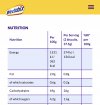General rules I try and stick to:
no bread of any sort
no pasta
no pulses, including peas and broad beans
no oats, barley, rice or wheat (or things made from them - cakes, biscuits etc.)
no root vegetables (there are a couple of exceptions e.g. radishes)
no added sugar or honey or jam
no fruit except for a few berries (i.e. 2 or 3 at a time)
no sweetcorn
plenty of leafy green vegetables: salad leaves of all sorts, lots of different cabbages, Brussel sprouts, watercress, pakchoi etc.
loads of mushrooms
small amounts of tomatoes and onions (mainly spring onions)
courgettes and aubergines
a variety of cheeses - both for meals and snacks
full-fat milk and full-fat yoghurt
eggs and more eggs
olives - both for meals and snacks
pork scratchings (a wonderfully indulgent treat, but watch out for your teeth)
Quorn pieces and mince
Beef
Chicken
Pork
Fish
When shopping, check the nutritional information on the back of packets. In the panel, it will typically show two columns of information. The one to pay attention to is the column under "per 100g". Check how many carbohydrates at shown in that column (not just sugars). If it's over 10g, it's too much for me. If it's between 5 and 10g then I might get it as a special treat. If it's 5g or less, then I can buy and eat it without worrying.
So for instance, Weetabix are shown as having 69g of carbohydrates per 100g: way, way, way too many carbs for me. I find it easier to check the per 100g column and avoid those foods that are higher than 10g. Some manufacturers attempt to bamboozle us by listing the per serving amount more prominently. I avoid the manufacturers that do this since I think they're trying to be deceptive.
A lot of the choices you're left with are (minus the potatoes and bread) what our parents and grandparents would have eaten.

